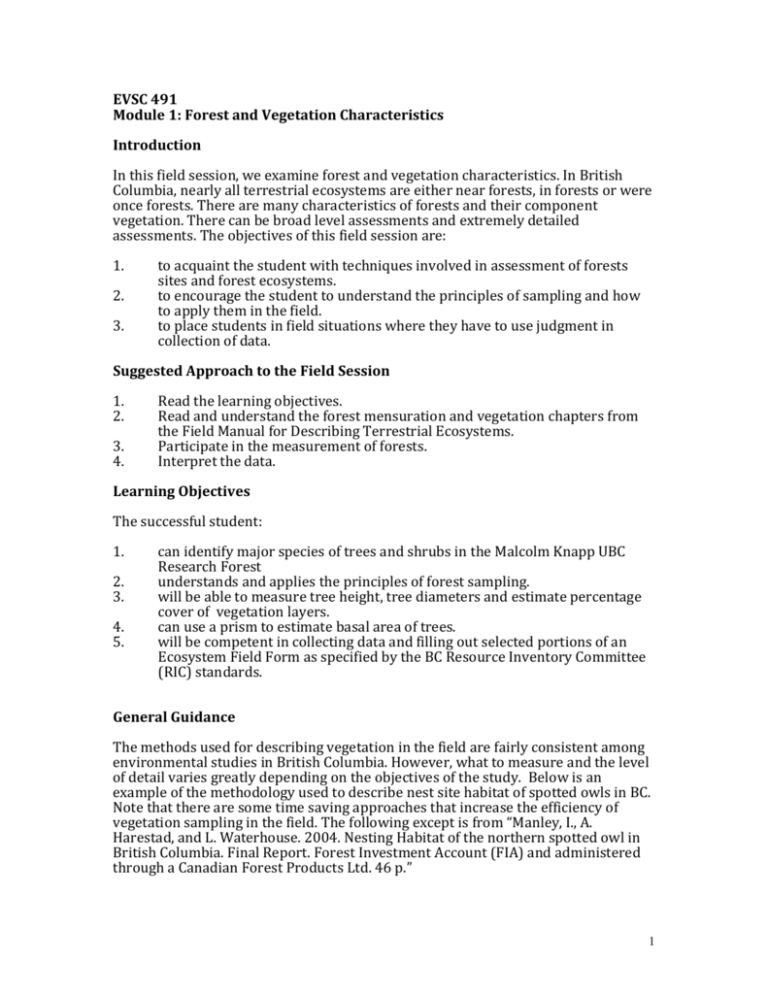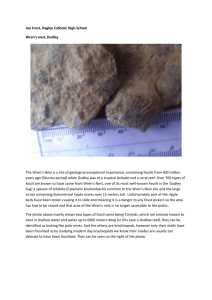Module 1: Forest and Vegetation Characteristics
advertisement

EVSC 491 Module 1: Forest and Vegetation Characteristics Introduction In this field session, we examine forest and vegetation characteristics. In British Columbia, nearly all terrestrial ecosystems are either near forests, in forests or were once forests. There are many characteristics of forests and their component vegetation. There can be broad level assessments and extremely detailed assessments. The objectives of this field session are: 1. 2. 3. to acquaint the student with techniques involved in assessment of forests sites and forest ecosystems. to encourage the student to understand the principles of sampling and how to apply them in the field. to place students in field situations where they have to use judgment in collection of data. Suggested Approach to the Field Session 1. 2. 3. 4. Read the learning objectives. Read and understand the forest mensuration and vegetation chapters from the Field Manual for Describing Terrestrial Ecosystems. Participate in the measurement of forests. Interpret the data. Learning Objectives The successful student: 1. 2. 3. 4. 5. can identify major species of trees and shrubs in the Malcolm Knapp UBC Research Forest understands and applies the principles of forest sampling. will be able to measure tree height, tree diameters and estimate percentage cover of vegetation layers. can use a prism to estimate basal area of trees. will be competent in collecting data and filling out selected portions of an Ecosystem Field Form as specified by the BC Resource Inventory Committee (RIC) standards. General Guidance The methods used for describing vegetation in the field are fairly consistent among environmental studies in British Columbia. However, what to measure and the level of detail varies greatly depending on the objectives of the study. Below is an example of the methodology used to describe nest site habitat of spotted owls in BC. Note that there are some time saving approaches that increase the efficiency of vegetation sampling in the field. The following except is from “Manley, I., A. Harestad, and L. Waterhouse. 2004. Nesting Habitat of the northern spotted owl in British Columbia. Final Report. Forest Investment Account (FIA) and administered through a Canadian Forest Products Ltd. 46 p.” 1 2 “Methods Vegetation analysis A multi-scaled approach to habitat analysis, similar to that described by Weir and Harestad (2003), was used to examine habitat selectivity at the spatial scales of the nest, nest patch, and nesting stand. At the patch level, characteristics of nest patches were measured and compared to random patches within the same stand. At the stand level, nest stands, adjacent stands and random stands were assessed through an analysis of airphotographs. Nest trees were described according to British Columbia Resource Inventory Committee Standards. Each nest tree was described or measured according to type of structure, aspect of the nest site, height above ground, and relative height (nest site versus tree height and nest site versus canopy height). Nest trees were classified using the tree attributes for wildlife, codes for appearance, crown condition, bark retention and wood condition following the standards of ‘Field Manual for Describing Terrestrial Ecosystems’ (Ministry of Forests and Ministry of Environment 1998). Features in the patches around nest trees were determined by establishing nested 7.98-m radius (0.02 ha) and 25-m radius (0.19 ha) plots centred on the nest tree. All plots were measured using slope corrected distances. Site characteristics recorded for the 25-m radius plot include elevation, slope, aspect and topography. Structural stage was described using the following categories: shrub; pole/sapling; young forest; mature forest; and old forest (Ministry of Forests and Ministry of Environment 1998). Detailed vegetation characteristics were measured within the 7.98-m radius plot. The percentage covers of each plant species occurring in the tree, shrub, herb and moss layers were estimated (Ministry of Forests and Ministry of Environment 1998). This information in conjunction with soil assessments was used to determine the nutrient regime, moisture regime and Biogeoclimatic site series at each nest. Shrub categories that may influence the occurrence of prey species for spotted owls were used to characterize sites. The percentage cover of evergreen shrubs and food producing shrubs (berries, hazelnuts) were calculated for each plot. Tree and stand structural characteristics were measured within the 25-m radius plot. Tree species, diameter at breast height (dbh), tree height and top condition were determined for all trees (with a diameter at breast height (dbh) >10 cm) within this plot. Tree height was measured for 1 tree from each layer using a clinometer and meter tape, and then estimated for the remaining trees. Snags and live trees with potential nesting structures within the plot were classified using the tree attributes for wildlife, categories for appearance, crown condition, bark retention and wood condition and wildlife use (Ministry of Forests and Ministry of Environment 1998). Additional notes on the presence and characteristics of snags with chimneys were recorded. For trees < 10 cm in dbh, stem density were recorded within the 25-m radius plot for each tree species. Canopy tree and snag densities were determined by measuring the distance to the nearest snag and nearest canopy tree in each of four 90-degree quadrants around the nest tree. Distances were measured using a tape measure or laser range finder. Coarse woody debris (CWD) was assessed in the nest patch by establishing two 25-m radial transects. The first transect was established on a random bearing and the second was located at 90 degrees from the first. CWD data, including the species, diameter, length and decay class, were measured for each piece > 7.5 cm in diameter crossing the transect line (Ministry of Forests and Ministry of Environment 1998). CWD data from transects were summarized to produce estimates of volume and average piece size in nest patches. Each nested set (i.e., statistically nested) of nest plots was paired with random plots situated in the same forest stand. Forest cover maps (1:20,000) were consulted to 2 ensure that the random plot fell within the same forest cover polygon as the nest tree. Random plots were located 60-100 m in a random direction from each nest tree, and centred on the nearest canopy tree or snag as the ‘random’ tree. Nested 7.98-m and 25-m radius plots were described as for nest plots. Airphoto stand level analyses Eleven nest sites visited during the course of field studies were identified on maps and air photographs. One additional nest site was not visited but was included in airphoto stand level analyses. On the air photographs, each polygon (stand) with a northern spotted owl nest (n=12) and all polygons adjacent to the nest polygon (i.e., sharing a boundary) were delineated using Vegetation Resource Inventory 2.4 standards (RIC 2003). For each nest polygon, one polygon >140-years from those adjacent was randomly selected thus forming a pair of nest and random polygons. Polygons of these pairs were interpreted for: age, height, crown closure, basal area, tree species, vertical complexity, crown complexity, occurrence of large trees, occurrence of gaps, forest cover pattern, crown complexity, and meso slope position (see Tables A1 and A2). Separately, a 500-m radius plot was estimated around the nest location and the percentage cover of each different stand type was recorded by vegetation type. If treed, the polygon was described by tree species and age (RIC 2003). The 500-m radius was used because current management recommends a 500-m radius reserve zone around known nest sites and critical roost sites (SOMIT 1997). In addition, the nearest distance to any stream (s1-s6), major stream or larger water body (lake or s1-s4 creeks), and to a talus slope (talus or talus/bedrock combined) were estimated because some prey of spotted owls may be associated with riparian habitats or talus slopes (e.g., Carey et al. 1992). Data analysis Characteristics of nest trees nest patches and nest stands were summarised by presenting mean, standard deviation and range for continuous variables and frequency or percentage for categorical variables. Some variables were also summarised by Biogeoclimatic zone (Interior Douglas-fir (IDF) or Coastal Western Hemlock zone (CWH)) to examine the influence of wetter climate on characteristics of nesting habitat. Characteristics of nest plots were compared to those of random plots to ascertain habitat selectivity at the within stand or patch level. Comparisons were made using Wilcoxon sign rank non-parametric tests to determine differences between paired nest and random plots. Categorical variables were compared between nest and random plots using Chi-square contingency tests. All statistical tests were conducted using SPSS version 12. Sample sizes in this study were small (n=11 or occasionally n=12) for most tests and we used a P value of 0.10 to indicate significance.” This excerpt is not a prescription. It is meant as a general protocol that may help guide some of your methodology for the forest plots. Hint on use of prisms for estimating basal area Ministry of Forests ecologists advised us to use 4BAF or 5BAF prisms when doing prism plots in coastal forests. You want to have approximately 4-5 trees/plot. 3







